Why Every Company Needs Professional Corporate Website Design?

In the current digital age, having a website is no longer merely an advantage; it has become an undeniable necessity for the survival and growth of any business.
#Professional_Corporate_Website_Design is your company’s online storefront that not only allows you to reach your potential and existing customers anytime, anywhere but also strengthens your brand identity.
A corporate website is your bridge to global audiences and can make the crucial difference between being seen and being forgotten.
Have you ever thought about how many business opportunities you miss without a strong online presence? Your website can serve as a powerful tool for marketing, sales, customer service, and even recruitment.
Digital marketing is practically incomplete without a central online base.
Companies can tell their brand story, introduce their products and services in detail, and enhance their credibility among competitors through their website.
This is not just a webpage; it is a comprehensive information hub, a powerful interaction tool, and a platform for increasing customer trust.
In fact, many customers first visit the company’s website to obtain initial information before any in-person or phone contact.
Therefore, the quality of your corporate website design will directly impact their initial perception of your business.
An up-to-date and user-friendly website is a sign of your professionalism and attention to detail.
Corporate websites allow you to have an active presence 24/7 and be accessible to your audience, even when your office is closed.
This continuous accessibility means uninterrupted opportunities for your business.
Are you dissatisfied with the low conversion rate of visitors to customers on your e-commerce website?
Solve this problem forever with professional e-commerce website design by Rasawp!
✅ Increase visitor-to-customer conversion rate
✅ Create an excellent user experience and build customer trust
⚡ Get free consultation
Key Features of a Successful Corporate Website Design
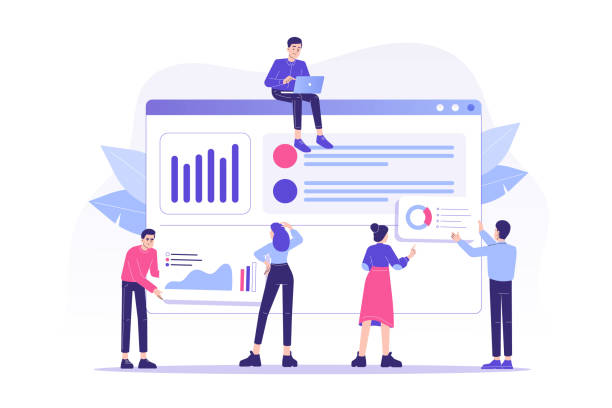
A successful corporate website design goes beyond mere aesthetics; it is a strategic investment that must support the company’s business objectives.
The first and perhaps most important feature is Responsiveness (Responsive Design).
Given the increasing use of mobile phones for browsing the internet, your website must display correctly and provide a consistent user experience across all devices, from desktops to tablets and smartphones.
The second feature is high loading speed.
Today’s users are impatient, and a slow website can immediately drive them away.
Optimizing images, code, and using appropriate hosting can significantly help increase site speed.
Quality and relevant content is the backbone of any website.
Texts should be clear, concise, and informative, and images and videos should be professional and engaging.
Using clear and prominent CTAs (Call to Action) guides users toward your desired actions, such as filling out a contact form, downloading a catalog, or purchasing a product.
Security is also of vital importance.
A corporate website must be secure against cyber attacks and protect user information.
Using an SSL certificate is an essential step in this regard.
Furthermore, the website should be easily navigable; menus should be logical and understandable so users can quickly find what they are looking for.
The contact us section should provide comprehensive information and various communication tools.
Integration with social networks can also help increase interaction and content sharing.
An ideal corporate website design, in addition to these points, should be optimized for search engines (SEO) to achieve high rankings in search results and attract organic traffic.
Attention to these features analytically demonstrates how a website can become a powerful tool for achieving your business goals.
Step-by-Step Process of Corporate Website Design
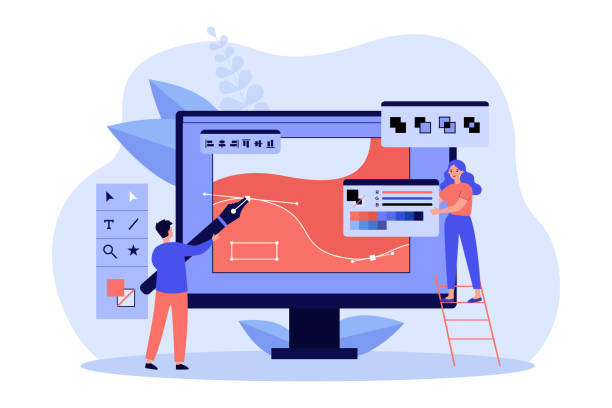
The corporate website design process has a clear path that begins with meticulous planning and continues with launch and maintenance.
These stages ensure that the final product aligns with your business goals and needs.
The first step is information gathering and needs analysis.
In this stage, the client and the design team meet to define the website’s goals, target audience, expected functionality, and necessary content.
This specialized stage is vital for a precise understanding of the project and allows us to create a strategic plan.
Next, comes the wireframe and prototype design stage.
In this section, the overall site structure, page layout, and user flow are schematically designed.
This is an instructive stage that allows the client to have an overall view of the site and provide feedback before spending significant time and money.
After structure approval, the graphic design (UI Design) stage begins.
In this section, the look and feel of the site, including colors, fonts, images, and other visual elements, are created in accordance with the company’s brand identity.
This stage is very exciting as the site begins to take shape.
The next step is implementation and coding (Development).
In this stage, front-end and back-end designers and developers convert graphic designs into actual code, making the site functional.
This section includes database development, Content Management Systems (CMS), and other technical functionalities.
After development, it’s time for testing and debugging.
The site is thoroughly checked for functionality, responsiveness, security, and compatibility with various browsers to resolve any potential errors or bugs.
Finally, there is the launch (Deployment) and maintenance stage.
The site is hosted on a server and made publicly accessible.
After launch, continuous monitoring, updates, and support are essential to ensure optimal site performance.
This comprehensive process is a guide for building a stable and effective corporate website.
| Stage | Description | Goal |
|---|---|---|
| 1. Needs Analysis |
Defining site goals, audience, and functionality. | Comprehensive understanding of the project and expectations. |
| 2. Wireframe and UI Design |
Schematic design of site structure and visual appearance. | Creating a visual roadmap and design approval. |
| 3. Coding and Implementation |
Converting design to executable code and developing functionalities. | Building a functional version of the site. |
| 4. Testing and Optimization |
Checking for errors, speed, and site responsiveness. | Ensuring correct functionality and excellent user experience. |
| 5. Launch and Support |
Publishing the site and providing ongoing maintenance services. | Maintaining site stability and continuous updates. |
Choosing the Right Platform for Your Corporate Website Design
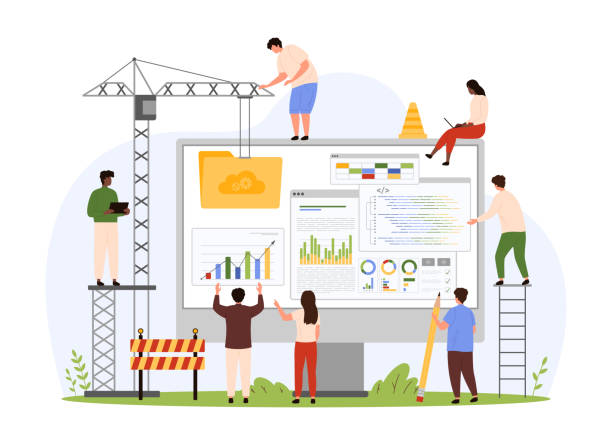
Choosing the right platform for your corporate website design is a crucial decision that impacts efficiency, flexibility, security, and long-term costs.
There are two main categories of platforms: Content Management Systems (CMS) like WordPress and Joomla, and web development frameworks like React and Angular, or entirely custom development.
Each has its own advantages and disadvantages, and their selection depends on your company’s specific needs.
WordPress, due to its ease of use, large user community, and countless plugins, is a very popular option for many businesses, especially small and medium-sized enterprises.
This platform allows for the creation of beautiful and efficient corporate websites at a lower cost and in a shorter time.
Did you know that over 40% of the world’s websites are built with WordPress? However, for companies with very specific needs, high functional complexities, or massive scalability, custom development using advanced frameworks might be a better solution.
This approach provides infinite flexibility and allows for the creation of unique features not found in off-the-shelf CMSs, but naturally requires more time and cost.
The important question is: Does your company need a ready-made and quick solution, or a highly flexible and scalable system? When choosing a platform, you must consider scalability, security, technical support, and maintenance costs.
Also, ensure that the chosen platform can integrate with other company systems such as CRM or ERP.
This is a specialized and important part of the guide for corporate website design.
An informed choice will be a solid foundation for the long-term success of your online presence.
Are you concerned about your e-commerce site’s low conversion rate and not achieving your desired sales?
Rasawp is your specialized solution for a successful e-commerce website.
✅ Significant increase in conversion rate and sales
✅ Professional and user-friendly design to gain customer satisfaction
⚡ Ready for a transformation in online sales? Get a free consultation!
The Importance of SEO in Corporate Website Design and Increasing Visibility
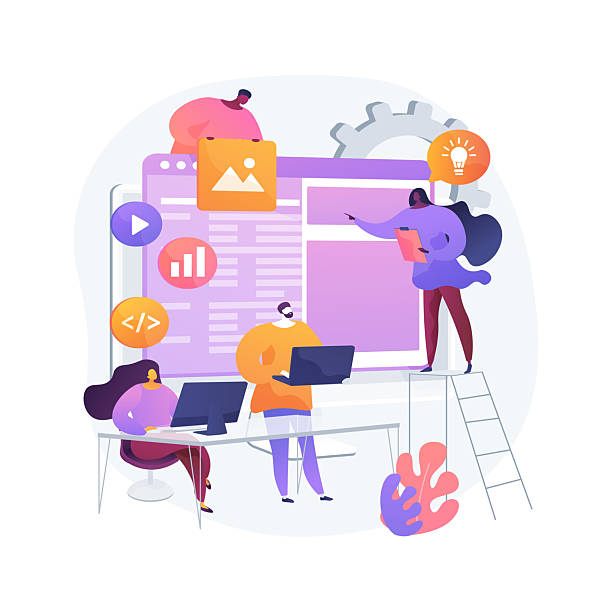
After the completion of corporate website design, the next crucial step is ensuring its visibility.
This is where Search Engine Optimization (SEO) comes into play.
SEO is a set of techniques and strategies that help your website achieve higher rankings in the search results of Google and other engines.
A higher ranking means more traffic, higher visibility, and ultimately more customers.
Without SEO, even the best and most beautiful corporate website might get lost among millions of other sites.
Think about how people search for your products or services. They use keywords in search engines.
Your website must be optimized for these keywords so that when a user searches for them, they can find your site.
SEO is not just about keywords; it also includes technical factors (such as site speed, URL structure, XML sitemap), content factors (such as content quality, regular updates, internal and external links), and off-site factors (such as backlinks and domain authority).
Did you know that most users only look at the first page of search results? Therefore, the main goal of SEO is to get there.
This is an analytical and specialized part of your online presence.
SEO is an ongoing process and must be regularly updated as search engine algorithms change.
Corporate website design should be carried out from the outset with SEO principles in mind to provide a strong foundation for future successes.
This includes using clean code, a logical page structure, and mobile optimization.
In fact, SEO is an investment for visibility and attracting potential customers organically and sustainably.
User Experience (UX) and User Interface (UI) in Corporate Website Design
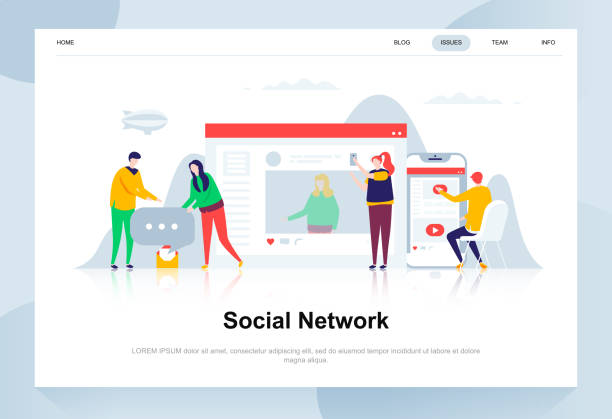
In the world of corporate website design, two concepts, UX (User Experience) and UI (User Interface), play pivotal roles and are often confused with each other, but both are vital for a website’s success.
User Interface (UI) refers to the look and feel of the website; the elements with which the user interacts, such as buttons, images, texts, layout, and colors.
An attractive and professional UI creates the first positive impression in the user’s mind and indicates the company’s credibility and attention to detail.
A good user interface should be visually appealing, brand-consistent, and intuitively understandable in terms of usability.
But User Experience (UX) refers to the entire user journey on the website; the emotions the user experiences during interaction with the site.
Is the website easily navigable? Can users quickly find what they are looking for? Is the purchase or contact process simple and hassle-free? UX addresses the logical arrangement of information, ease of use, loading speed, and website responsiveness across different devices.
A poor UX can render even the most beautiful UI ineffective.
Have you ever visited a site that looked beautiful but you couldn’t easily navigate it? This indicates a poor UX.
The goal of good UX design is to create a positive, efficient, and enjoyable experience for the user, encouraging them to stay longer on the site, return, and perform your desired actions.
A corporate website with excellent UX/UI not only looks professional but also effectively contributes to your business goals and can become a powerful tool in attracting and retaining customers.
These two concepts must be considered simultaneously and together in the corporate website design process to achieve an optimal and effective outcome.
This is expert guidance that every web designer should master.
Corporate Website Security and Maintenance After Design
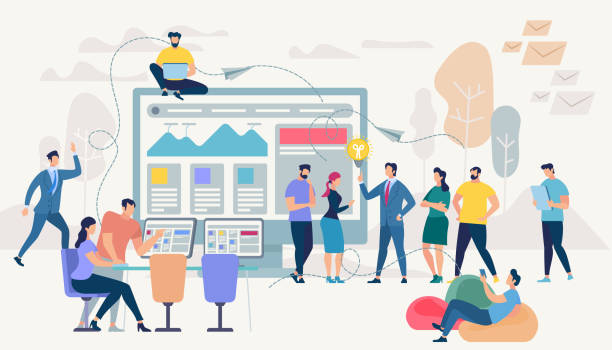
After the completion of corporate website design and its launch, your work does not end; rather, the vital phase of ongoing security and maintenance begins.
Websites, like any other digital asset, are constantly exposed to security threats and require technical updates.
Neglecting this aspect can lead to data loss, brand reputation damage, or even website downtime.
Did you know that cyberattacks are becoming more sophisticated every day, and no website is immune to them? The first step in security is using an SSL certificate to encrypt communications, which protects user data and is also effective for SEO.
Regularly updating the Content Management System (CMS), plugins, and themes used is essential to close security vulnerabilities that might be exploited by hackers.
Additionally, using strong passwords, regularly backing up site data and databases, and employing Web Application Firewalls (WAFs) are other important security measures.
Cybersecurity is a daily news topic and a very important issue.
In addition to security, regular maintenance includes checking for broken links, optimizing the database, verifying form functionality, and ensuring site loading speed.
These actions not only improve the user experience but also contribute to your site’s SEO ranking.
A well-maintained website indicates your company’s professionalism and commitment.
Providing technical support after corporate website design assures customers that a specialized team will be there to resolve any issues.
This section provides explanatory guidance, emphasizing the importance of site stability and health.
| Action | Description | Frequency |
|---|---|---|
| SSL Installation | Encrypting data and increasing trust. | One-time and annual renewal. |
| Updating CMS and Plugins | Patching security vulnerabilities and improving performance. | Weekly/Monthly. |
| Regular Backups | Protecting data against loss. | Daily/Weekly. |
| Performance Monitoring | Checking speed, broken links, and technical issues. | Weekly. |
| Periodic Security Checks | Scanning for vulnerabilities and preventing attacks. | Monthly/Quarterly. |
Common Mistakes in Corporate Website Design to Avoid
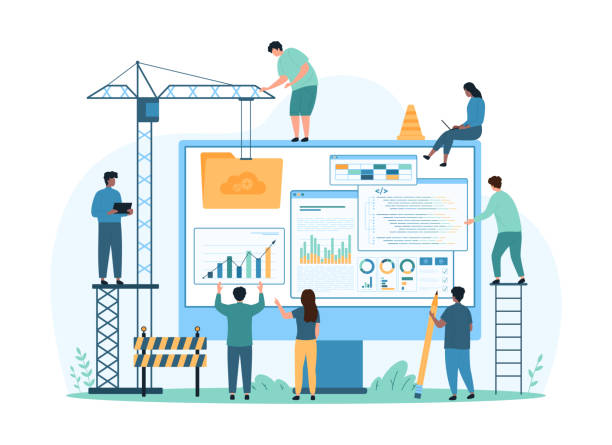
On the path of corporate website design, there are some common mistakes that can render your efforts and investment ineffective.
Awareness of these mistakes and avoiding them is essential for achieving a successful website.
One of the biggest mistakes is neglecting User Experience (UX).
A site that is beautiful but difficult to navigate or where needed information is not easily found will quickly frustrate users.
Is your website designed so that a user can find their goal within a few seconds? Lack of mobile optimization is another critical error.
Given that a significant portion of internet traffic comes from mobile devices, your website must display and function well across all screen sizes.
Ignoring SEO from the very beginning of corporate website development is another mistake that leads to the site not being visible in search engines.
Poor or insufficient content can also discourage audiences.
Your website must provide accurate, up-to-date, and useful information.
Does your content answer frequently asked customer questions and create added value? Excessive use of heavy visual elements, such as high-volume images or too many animations, can severely reduce site loading speed and prevent users from staying on the site.
Also, the absence of clear and specific Call to Action (CTA) causes users not to know what to do after visiting a page.
Another common mistake is not tracking and analyzing site performance after launch.
The website should be continuously monitored and improved based on data.
Do you use analytical tools like Google Analytics to examine user behavior? These are important questions whose answers can help you avoid failure in corporate website design and serve as a guide for ideal site design.
Is your company’s website as professional and trustworthy as it should be? With specialized corporate website design by Rasawp, create an online presence that reflects your credibility and attracts more customers.
✅ Build a powerful and professional image for your brand
✅ Convert visitors into real customers
⚡ Get a free consultation now!
Measuring Success and Analyzing Corporate Website Performance

After the completion of corporate website design and its launch, the question arises: has this investment paid off? Measuring website success and analyzing its performance is a vital step to ensure the achievement of business goals.
Without data analysis, you are merely guessing.
Analytical tools like Google Analytics provide valuable information about website visitors, their behavior, traffic sources, and conversion rates.
Key Performance Indicators (KPIs) for a corporate website can include the number of unique visitors, average time on site, Bounce Rate, pages visited per session, and most importantly, the conversion rate.
The conversion rate refers to the percentage of visitors who perform a desired action (such as filling out a contact form, downloading a catalog, or requesting a consultation).
These analyses help you identify your website’s strengths and weaknesses and make data-driven decisions for its improvement.
Do you know which pages have the most views and which pages need content or design improvements? By analyzing user paths, you can understand where users enter the site, where they pause, and where they leave the site.
These insights allow you to improve the user experience and optimize conversion paths.
Regular reports on website performance should be prepared and presented to the relevant teams.
This continuous analytical process not only helps you measure your Return on Investment (ROI) from corporate website design but also provides ongoing guidance for improving your marketing and sales strategies.
This analytical approach allows you to transform your website into a dynamic and efficient marketing tool.
Future Trends in Corporate Website Design and the Digital Future

The world of corporate website design is constantly evolving, and new trends emerge in line with technological advancements and changing user expectations.
Awareness of these trends is essential to maintain competitiveness and ensure that your website remains effective in the future.
One of the most important future trends is Personalized User Experience (Personalized UX).
Websites will increasingly use user data to provide more relevant content, products, and services, which leads to increased engagement and conversion rates.
Is your website capable of learning from user behavior and providing unique experiences? Artificial intelligence (AI) and machine learning will also play a significant role in the future of corporate website design, from advanced chatbots for customer support to content optimization based on data analysis.
Voice search is also on the rise, and websites must be optimized to respond to these types of searches.
This is important news for SEO specialists.
Sustainability and green design have also become important topics, focusing on building websites that consume less energy and cause less harm to the environment.
Minimalist and simplistic designs, focusing on core content and easy navigation, will continue to maintain their popularity.
Additionally, Augmented Reality (AR) and Virtual Reality (VR) may offer new interactive experiences on corporate websites in the near future, especially for companies with physical products.
These trends are a thought-provoking content about the digital future.
Future corporate website design will be increasingly focused on intelligent interactions, personalization, and sustainability.
Companies that embrace these trends will be able to lead in the constantly changing digital landscape and provide unparalleled experiences for their users.
This is a fascinating yet analytical guide to the future.
Frequently Asked Questions
| Question | Answer |
|---|---|
| What is a corporate website? | A website that introduces the identity, products, services, and contact information of a company to potential audiences and customers. |
| Why do companies need a corporate website? | To establish an online presence, enhance brand credibility, attract new customers, provide information 24/7, and improve communication with the audience. |
| What are the features of a good corporate website? | Professional and attractive design, user-friendliness (proper UI/UX), high loading speed, responsiveness, high security, and quality content. |
| What is meant by Responsive Design in corporate websites? | It means designing a website whose appearance and functionality automatically adjust to the screen size of the user’s device (mobile, tablet, desktop). |
| What is the importance of SEO for a corporate website? | SEO helps the website achieve higher rankings in search engine results like Google and attract more organic traffic, leading to increased company visibility. |
| What are the main stages of corporate website design? | Includes needs assessment and planning, User Interface (UI) and User Experience (UX) design, coding (Front-end and Back-end), content creation, testing, and launch. |
| How long does it take to design a corporate website? | It varies depending on project complexity, required features, content volume, and the speed of interaction between the client and the design team, but typically takes from a few weeks to several months. |
| What information should be present on a corporate website? | About Us (company introduction), products or services, contact methods, an attractive homepage, portfolio (if necessary), and sometimes a blog or company news. |
| Does a corporate website need updates? | Yes, regular updates are essential to maintain security, improve performance, add new information (products, services, news), and keep it appealing to users. |
| What factors determine the cost of corporate website design? | It depends on factors such as design complexity, specific features and functionalities, content volume, Content Management System (CMS), expertise of the design team, and the need for additional services like SEO or content creation. |
And other services of Rasa Web Advertising Agency in the field of advertising
The role of interactive advertisements in enhancing the brand credibility of audio and visual equipment manufacturers
Examining the impact of digital advertising on the sales of audio and visual equipment manufacturers
How to use timed ads on industrial websites of audio and visual equipment manufacturers
Investigating the role of advertisements in the online market development for audio and visual equipment manufacturers
How to use local SEO techniques in industrial advertisements for audio and visual equipment manufacturers
And more than hundreds of other services in the field of internet advertising, advertising consultation, and organizational solutions
Internet Advertising | Advertising Strategy | Advertorial
🚀 Transform your business’s digital presence with Rasa Web’s internet advertising strategies and advertorials.
📍 Tehran, Mirdamad Street, next to Bank Markazi, Kazeroun South Alley, Ramin Alley, No. 6




